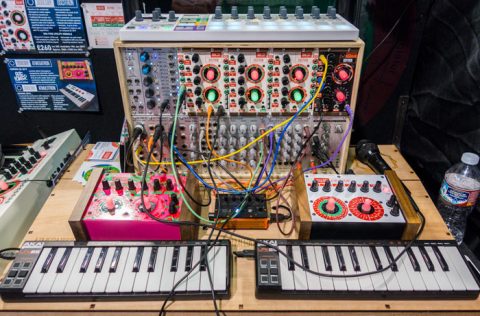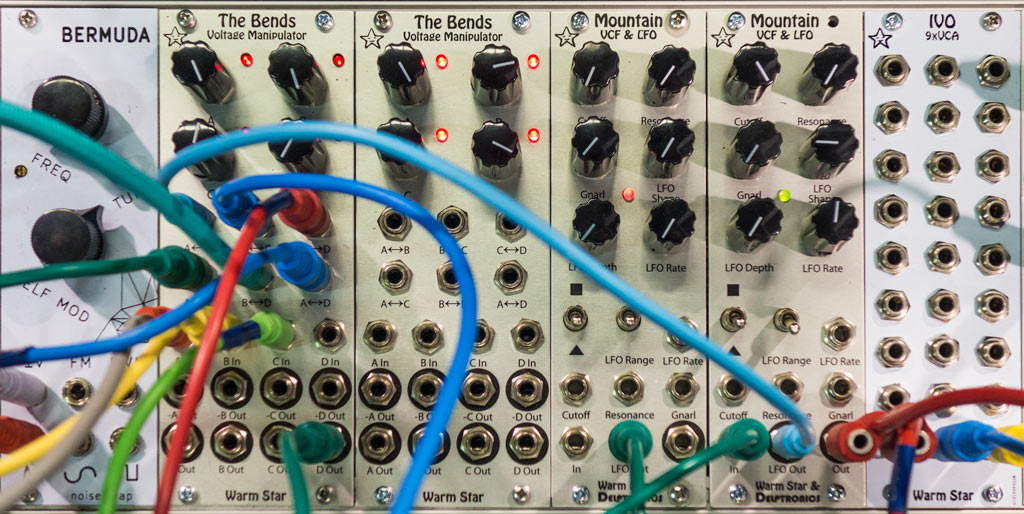After focusing on some of the more advanced modules available in the previous installment, let’s go for some contrast and talk about a few unabashedly low-fi additions to a Eurorack system – from 8-bit digital oscillators to old school analog recreations – all found inside the #5000 mega-booth at NAMM:
Soulsby Synthesizers

The Oscitron contains 32 low-resolution 8-bit waveforms with 128 samples per wave and variable sample rate clock, meaning you will get digital aliasing in all of its glory as you play lower pitches (this is one of the secrets to the sound of the PPG Wave and Prophet VS). If that wasn’t grungy enough, you can also dial the waveforms back to 64, 32, or just 16 samples; the oscillator will simply skip the undesired samples rather than perform any interpolation or smoothing (again, in stark contrast to what Dave Rossum was focusing on with his Assimil8or design). It can also sample an external input to create new waveforms: it will either automatically trim the incoming sound to a single cycle and stretch it out to 128 samples, or continuously update the wavetable with whatever is coming through the input to crunch sound on the fly.
But wait – there’s more! A “phaser” effect runs a second copy of the oscillator and allows you to offset it in time to create phase cancellation; the amount of phase is under voltage control. This insane oscillator section is followed by an 8-bit biquad filter with 15 different algorithms and, to quote Paul, zero headroom (so yes, it can clip – quite nastily). If that’s not nasty enough, it also has a “wavecrusher” to introduce more quantization distortion and noise into the final result.
The Oscitron normally has 0-5v control ranges. As many modulation signals – even pitch CVs – can be biploar and possibly with a wider range, the Oscitron comes bundled with a Uni-Five module that can offset bipolar inputs to the unipolar 0-5v range the Oscitron requires. It has three channels of these converters with input attenuators inside 2hp. The two modules combined retail for 260 UK pounds.
And if you order now (well, anytime, but I’ve got to keep the infomercial vibe going), the Oscitron comes with wood end cheeks – in the form of bars that sit across the top and bottom of the module. They’re optional if you don’t like them, but they do help keep the front panel graphics overlay in place. Why an overlay? Because the Oscitron – being powered behind the curtain by the same processor as an Arduino – can be reprogrammed to provide different behaviors. First up is an Odytron alternate personality (at right in the image at the top) that mimics an Arp Odyssey…if an Odyssey had been realized in 8-bit digital rather than analog. It contains two oscillators with analog-style waveforms including FM and ring modulation, a different filter configuration with resonance and more headroom, and more. You can reprogram your Oscitron as desired to take on either personality.
Catalyst Audio
Some of you may have heard about Catalyst Audio through their advanced Time’s Arrow Generative Pattern Sequencer. If you have, their sharp left-turn at this show was completely unexpected: faithful recreations of a set of five Buchla 100 series modules, complete with original components and all of the quirks designed into the originals. From left to right in the photo above:
- The Model 156 Control Voltage Processor: This two-channel unit crossfades between two inputs, and the crossfades between that result and a bias voltage offset. The right side inverts one of the inputs. Buchla referred to attenuating an input voltage as “compressing” its range; that’s why sometimes you’ll see this module described as compressing control voltages (don’t confuse it with an audio compressor). It was considered to be an essential control voltage front-end from the Model 158:
- The Model 158 Dual Sine-Sawtooth Generator: A dual oscillator with very wide frequency range and continuously variable waveforms from sine wave to sawtooth, as well as exponential frequency modulation including internal cross-modulation. The sound was wild without being overly harsh, inviting you to twist away madly. I was warned that it’s tracking is not exactly what you would call wide-range and accurate.
- The Model 106 6 Channel Mixer: This is a recreation of the mixer mentioned in my recent Buchla MArF article. It is not a high-fidelity mixer. The original Buchla systems only had a unipolar power supply (no negative voltage rail), but of course audio is bipolar. To deal with this, the 106 adds a positive voltage to the incoming audio to center it in the available voltage range, mixes the signals, and then use a capacitor to AC couple the audio output re-centering it around 0 volts. Catalyst describes this as resulting in “low headroom” and an “extra-beefy analog sound” with non-linear distortion.
- The Model 180 Dual Attack Generator: An ASR shape dual envelope generator with sustain being tied either to the incoming gate duration, or a Note Duration control on the module. Attack time goes from 5 msec to 1 second; release (labeled Decay on the module) goes from 10 msec to 5 seconds. The envelope curve is linear rather than exponential/logarithmic shape found on Moog units of the era.
- The Model 110 Quad Gate: A quad non-linear VCA. It suffered (or benefitted, depending on your perspective) from the same unipolar power supply design issue as the mixer, coupled with a discrete transistor design. Catalyst describes its response as being “roughly exponential in the first 1/3 of its range, approximately linear over the middle 1/3, and increasingly logarithmic as it begins to saturate at the upper edge of it’s range.”

Prices and release dates have not been set yet (Catalyst still needs to figure out manufacturing, as well as source a lot of rare analog components such as tantalum capacitors that cost a few bucks each), and neither are the panels final; these were strictly proof-of-concept prototypes. But oddly enough, I found myself even more excited about these than many other modules at the show.
Warm Star
Warm Star Electronics – creators of the Shape Shifter Mountain stompbox – entered the Eurorack world at NAMM with their new Mountain VCF + LFO, plus The Bends: a “voltage manipulator” with that adds inputs in interesting ways.
The Mountain ($195, shipping this spring, created with the help of Delptronics) is a four-pole low pass filter based on the SSM2044 chip with a couple of twists. One is a “Gnarl” control, which frequency modulates the filter cutoff with the input signal after it has been passed through a separate 1-pole low pass filter. This helps take some of the noise and hash out of the result with complex waveforms. I can attest that Gnarl added a good dose of aggression without becoming unusable, as can happen with a similar patch. A second twist is the inclusion of an LFO that can be accessed separately or applied to the filter’s cutoff.
The Bends (also $195 and shipping this spring) is a slightly different take on a control voltage mixer. It has four inputs with attenuators routed to both positive and inverted outputs. If nothing is plugged into an input, it is replaced with a DC voltage, turning its attenuator into an offset control. What makes it unusual is that it also has a set of six additional control voltage inputs that adds inputs into each other – such as adding some of input A into output B as well as input B into output A. The effect is additive, rather than a crossfade, meaning you can have one CV such as an envelope and then use The Bends to add, say, and LFO to it under voltage control without reducing the envelope’s strength. At least, that’s how I understood it; I’d be curious to play with one away from the chaos of NAMM.
By the way, Warm Star was also generously pushing the company Noise Reap, who was not at NAMM. They appreciate Noise Reap’s low-cost approach to creating introductory modules, such as their Bermuda oscillator which only tracks for about a 3 octaves (and let’s be honest here – many synth lines stay within a couple of octaves), but costs only $65 and includes features like FM and PWM as well as self-modulation. This cross-promotion between companies was common among modular manufacturers at NAMM, and is one of the more refreshing aspects of this industry.
Tomorrow night I’m going to the Analogue Haven NAMM After Party and then traveling home, so I’m not sure when the next updates are going to go up – but I promise to resume no later than this weekend and will continue until I’ve gone through everything I saw interesting in the modular world at NAMM.



